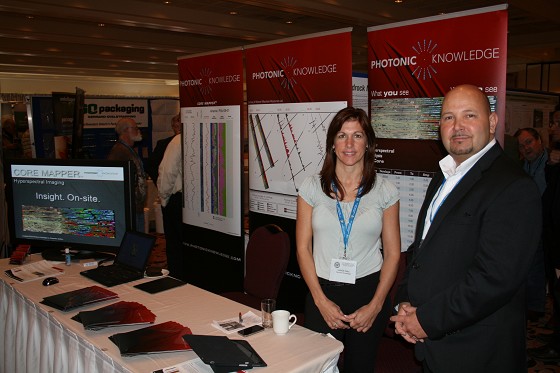Northwestern Ontario Mines and Minerals Symposium Continues to Grow
by Scott A. Sumner
Each spring geologists and others involved in the mining business come together in Thunder Bay to talk about their industry. This year’s event reflected the buoyant feel for the mining industry in NW Ontario.
“ The show is bigger again this year. We had 440 preregistered for the show, the most ever, which includes exhibitors as well as walk in crowd. There are 96 booths and 32 speakers. We have people here from all over Canada and the US as well as a couple from Australia. Our show
is similar to how the Toronto show started in the 40’s or 50’s. These regional shows are really focused on the smaller area while Toronto focuses on the world.” said Gary Clarke Executive Director of the Ontario Prospectors Association, and a graduate geologist from Lakehead
University.
A major topic area of NW Ontario mining is the Ring of Fire and the other is there has been a lot of gold mineralization defined in the area according to Clarke.
“ The gold has been known but now defined. The price of commodities has a lot to do with that as we can look at lower grade gold deposits and spend more money looking. The more you spend on exploration the more you find. There are greater than 25 million ozs of gold defined now. Gold is priced extremely high compared to a few years ago.” said
Clarke.
Given all this interest in mining in NW Ontario can we expect mines to grow in number. “ I think you will see all these mining projects move forward - the Atikokan, Dryden, Rainy River, Beardmore and Geraldton areas will all move ahead and see if they are economic. The
Ring of Fire just seems to keep moving along. It will take a while but they are still spending lots of money there. Musselwhite continues to go. Lac Des Illes keeps expanding and we are going to add some more. The project out of Marathon, Stillwater, is continuing to get going and it looks like they have secured some financing so it looks good,” said Clarke. “ This will create a lot of activity in NW Ontario with a real focus on Thunder Bay as a jump off point for the contractors, suppliers
and employees who may be based here. In my eyes it is similar to the Steep Rock development in the past at Atikokan. It was huge then, a world class deposit and a world class engineering feat to get at the ore.”

An interesting exhibitor at the Northwestern Ontario Mines and Minerals Symposium was Photonic Knowledge from Rosemere, Quebec
This high tech company offers a new approach on site to reviewing drilling results. “ We take any kind of mineralization and offer analysis of to 1500 meters of core per day, giving the results on site to the client. It is hyperspectral technology,” said Yves Jodoin, Director of Sales & Operations. “ The geologist uses the service because we have very fast and accurate results on site. Time is money so it helps them to make faster decisions as well as plan their next hole. It will also help them in choosing the right samples to send to the assay lab and helps taking subjectivity out of logging. They want to make sure the next hole hits and this will give them rapidly a fast
view in a 3D model. Drilling a hole will cost between $100 to $200 per meter and you want to get good results. The holes range from 50 to 2000 meters in depth but average 200 to 400 meters. The results at the lab can take 4 weeks to 3 months. We offer speed and accuracy with our
mobile laboratory.”









